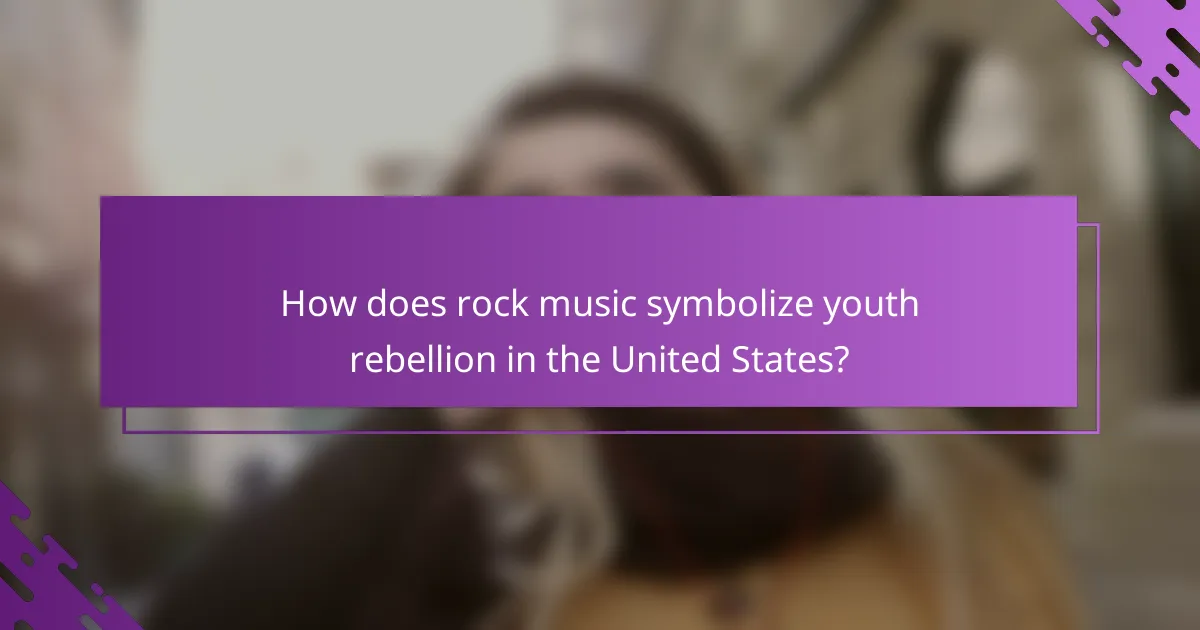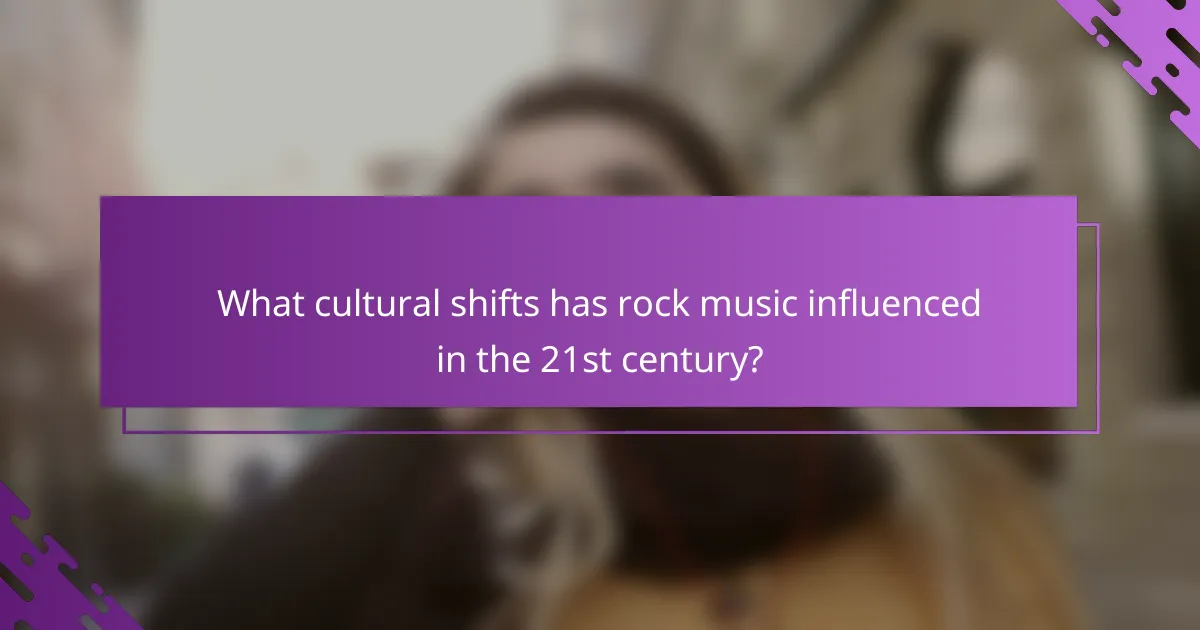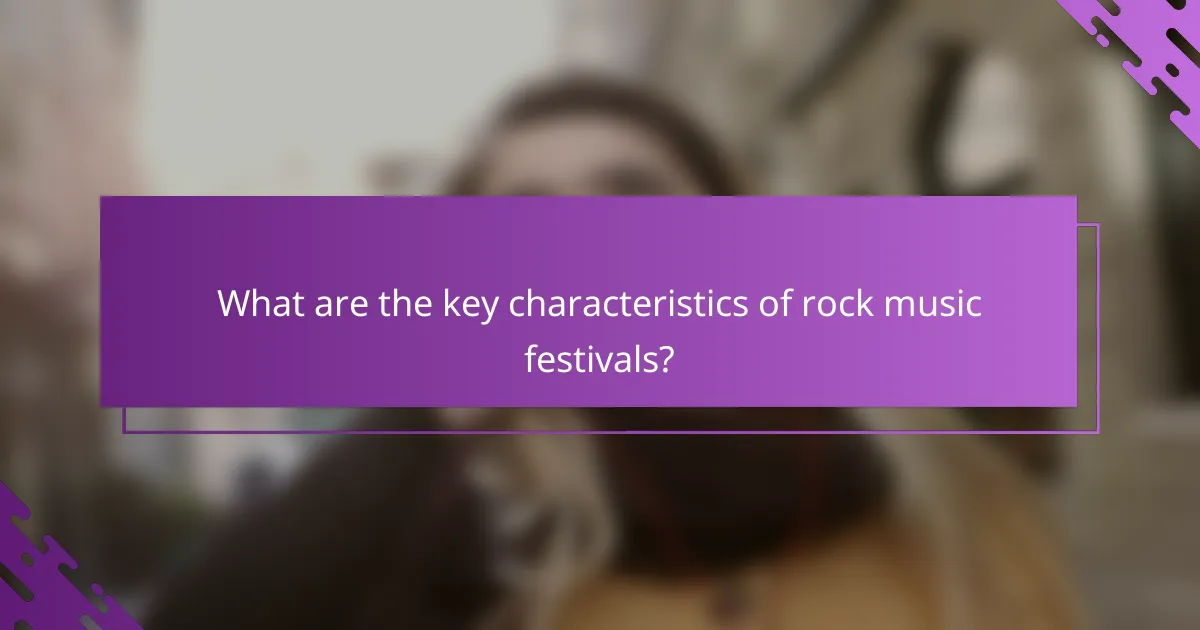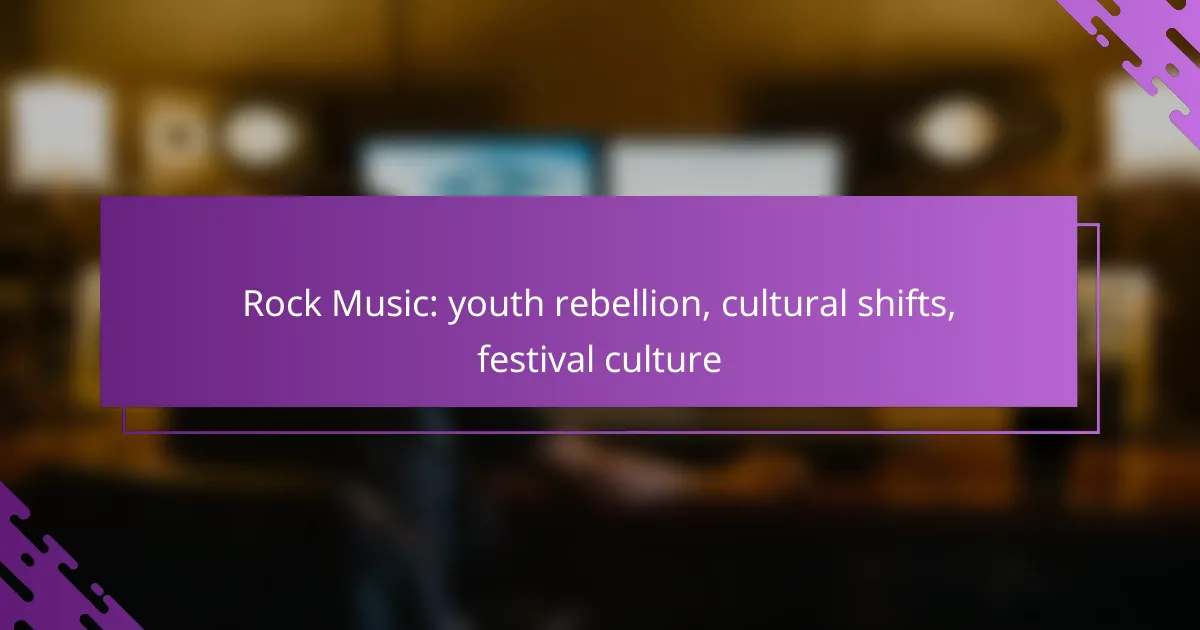Rock music has long been a powerful emblem of youth rebellion, channeling the frustrations and aspirations of young people eager to defy societal norms. As it evolves, rock continues to influence cultural shifts, promoting inclusivity and challenging traditional attitudes toward gender and social issues. Additionally, the rise of festival culture has redefined music experiences, creating vibrant spaces where art, community, and self-expression converge.

How does rock music symbolize youth rebellion in the United States?
Rock music serves as a powerful symbol of youth rebellion in the United States by expressing the frustrations and desires of young people seeking to challenge societal norms. Its raw energy and provocative themes resonate with generations, making it a vehicle for self-expression and cultural change.
Counterculture movements
Rock music has been at the forefront of various counterculture movements, particularly during the 1960s and 1970s. Artists like Bob Dylan and The Beatles became voices for social change, addressing issues such as civil rights, anti-war sentiments, and personal freedom. This music not only reflected the attitudes of youth but also inspired them to take action against established conventions.
Festivals like Woodstock in 1969 epitomized this counterculture, bringing together thousands to celebrate peace, love, and music. Such events became a platform for expressing dissent against the Vietnam War and advocating for social justice, solidifying rock’s role in youth rebellion.
Influence of iconic bands
Iconic bands like The Rolling Stones, Nirvana, and Green Day have significantly influenced youth rebellion through their music and public personas. Their lyrics often challenge authority and question societal expectations, resonating with young audiences who feel marginalized or misunderstood. For instance, Nirvana’s “Smells Like Teen Spirit” became an anthem for disaffected youth in the early 1990s.
These bands not only shaped musical trends but also set cultural standards, encouraging young people to embrace individuality and reject conformity. Their impact extends beyond music, influencing fashion, language, and attitudes towards various social issues.
Lyrics reflecting societal issues
Rock music lyrics frequently address pressing societal issues, making them a form of protest and commentary. Songs about poverty, inequality, and mental health resonate deeply with listeners, providing a voice for those who feel unheard. For example, Bruce Springsteen’s “Born to Run” captures the struggles of working-class youth seeking escape and fulfillment.
Moreover, the genre’s ability to articulate complex emotions and societal frustrations allows listeners to connect on a personal level. This connection fosters a sense of community among fans, reinforcing rock music’s role as a catalyst for youth rebellion and cultural shifts.

What cultural shifts has rock music influenced in the 21st century?
Rock music has significantly influenced cultural shifts in the 21st century by challenging societal norms and fostering inclusivity. It has played a pivotal role in reshaping attitudes towards gender, genre diversity, and social activism.
Gender representation in music
In recent years, rock music has seen a notable increase in female representation, with artists like Hayley Williams and St. Vincent leading the charge. This shift has encouraged a more balanced portrayal of gender in the industry, allowing for diverse voices and perspectives to emerge.
Moreover, initiatives aimed at promoting women in music festivals and awards have gained traction, helping to address historical imbalances. This has resulted in a more equitable platform for female artists, fostering a sense of community and empowerment.
Integration of diverse genres
The 21st century has witnessed rock music’s integration with various genres, including hip-hop, electronic, and pop. This blending has created innovative sounds and broadened the appeal of rock, attracting a wider audience.
Collaborations between rock artists and musicians from other genres have become increasingly common, leading to unique cross-genre projects. For example, artists like Post Malone and Lil Nas X have incorporated rock elements into their music, further blurring genre lines.
Impact on social movements
Rock music has historically been a voice for social change, and this trend continues today. Many contemporary rock artists use their platforms to advocate for issues such as climate change, racial equality, and mental health awareness.
Benefit concerts and activism-driven tours have become prevalent, with artists leveraging their influence to mobilize fans for various causes. This engagement not only raises awareness but also fosters a sense of solidarity among listeners, reinforcing rock music’s role as a catalyst for social movements.

How has festival culture evolved in North America?
Festival culture in North America has transformed significantly over the past few decades, becoming a central aspect of music and youth culture. Major events now attract hundreds of thousands of attendees, blending music, art, and community engagement.
Growth of major festivals like Coachella
Major festivals such as Coachella have seen exponential growth since their inception, expanding from a small gathering to a global phenomenon. These festivals now feature a diverse lineup of artists, art installations, and immersive experiences, drawing attendees from across the continent and beyond.
The success of Coachella has inspired numerous other festivals, leading to a proliferation of events throughout North America. Many festivals now incorporate unique themes and experiences to differentiate themselves, contributing to a vibrant festival landscape.
Role of social media in festival promotion
Social media plays a crucial role in the promotion of festivals, allowing organizers to reach a vast audience quickly and effectively. Platforms like Instagram, TikTok, and Twitter are used to share announcements, lineups, and behind-the-scenes content, creating buzz and anticipation.
Influencers and attendees often share their experiences in real-time, further amplifying the festival’s reach. This organic promotion can significantly impact ticket sales, as potential attendees are influenced by the experiences of their peers.
Economic impact on local communities
Festivals contribute significantly to the local economy by generating revenue through tourism, hospitality, and retail. Cities hosting major events often see a boost in hotel bookings, restaurant sales, and local business patronage during festival weekends.
However, the economic benefits can vary. While some communities thrive from the influx of visitors, others may face challenges such as increased traffic and noise. It’s essential for local governments to balance the benefits with potential disruptions to ensure a positive experience for both visitors and residents.

What are the key characteristics of rock music festivals?
Rock music festivals are vibrant events characterized by diverse lineups, engaging fan activities, and extensive merchandising opportunities. These festivals not only showcase a variety of artists but also create immersive experiences for attendees, making them a cornerstone of rock culture.
Lineup diversity
Lineup diversity is crucial for rock music festivals, as it attracts a wide range of fans and enhances the overall experience. Festivals typically feature a mix of established headliners and emerging artists across various rock subgenres, from classic rock to punk and metal. This variety ensures that attendees can discover new music while enjoying their favorite bands.
For example, a festival might include acts like a legendary rock band alongside indie newcomers and local talent. This blend can help foster a sense of community and encourage cross-genre appreciation among festival-goers.
Fan engagement activities
Fan engagement activities are essential for creating memorable experiences at rock music festivals. These activities can include meet-and-greets with artists, interactive workshops, and live Q&A sessions. Such opportunities allow fans to connect with their favorite musicians and deepen their appreciation for the music.
Additionally, many festivals offer unique experiences like art installations, food tastings, and themed areas that reflect the festival’s ethos. Engaging fans in these ways can enhance their overall enjoyment and encourage them to return in future years.
Merchandising opportunities
Merchandising opportunities play a significant role in the financial success of rock music festivals. Vendors often sell a variety of products, including band merchandise, festival-branded items, and local crafts. This not only provides fans with tangible memories but also supports local economies.
Festivals typically feature designated merchandise areas where attendees can browse and purchase items. Offering exclusive festival merchandise can increase sales and create a sense of urgency, as fans often want to take home something unique from their experience.

How do rock festivals contribute to youth culture?
Rock festivals play a significant role in shaping youth culture by providing a space for social interaction, self-expression, and community engagement. These events foster a sense of belonging among young people, allowing them to connect over shared musical interests and cultural values.
Community building
Rock festivals create a vibrant community atmosphere where attendees can meet like-minded individuals. This sense of community is often enhanced by shared experiences, such as enjoying live performances, camping together, or participating in festival activities. Many festivals also promote inclusivity, welcoming diverse groups and encouraging connections across different backgrounds.
Additionally, local economies benefit from rock festivals, as they draw visitors who spend on accommodations, food, and merchandise. This economic boost can strengthen community ties, as local businesses become integral to the festival experience.
Expression of identity
Rock festivals serve as a platform for young people to express their identities through fashion, music preferences, and lifestyle choices. Attendees often showcase unique styles that reflect their personalities and subcultures, from punk to indie to metal. This self-expression is a crucial aspect of youth culture, allowing individuals to assert their identities in a supportive environment.
Moreover, many festivals feature a diverse lineup of artists, enabling attendees to explore various genres and discover new music. This exposure can influence personal tastes and inspire young people to engage more deeply with the music scene, further solidifying their identity within the broader cultural landscape.
